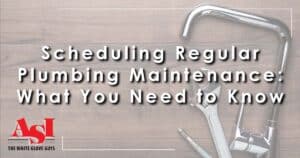There are more than a few plumbing materials that make up your whole system. Even though we recommend all plumbing jobs to be done by professionals, it’s just good to know what’s being used in your home.
Not only will this help you better understand the work that plumbing maintenance entails, but it will also allow you to understand the pros and cons of specific materials.
PEX Piping
PEX piping is a cross-linked polyethylene pipe that has gained tremendous popularity within the residential plumbing market. PEX piping is exceptionally flexible and versatile, which allows the pipe to easily weave throughout ceilings, walls, and crawl spaces.
This plastic piping is color-coded, with red for hot water and blue for cold water. It even incorporates push-fit plumbing fittings, which make completing jobs easier.
While there are many positives to using PEX piping within your home, homeowners should also be aware of the possible downfalls of this material. One of the biggest drawbacks is that PEX can’t be exposed to the sun. UV rays will weaken the pipes and break them down. All PEX piping needs to be underground or behind walls.
Copper Pipes
Copper pipes are most commonly used for water supply lines. This material has been used within residential homes for decades and can be found around sinks, showers, and tubs.
Copper is a prevalent material in water supply lines due to the fact that it does not corrode or affect the quality of drinking water. While it does cost more than plastic, it lasts longer as well.
However, there are some drawbacks. During installation, a propane torch must be used to apply heat to the joists. The perfect amount of heat must be applied in order to create a proper connection. We urge all homeowners to leave copper pipe installation to the professionals.
PVC Pipes
PVC pipe is made from polyvinyl chloride and can be found within most home sewage systems. This style of plumbing material initially gained popularity within the market due to the fact that it is much lighter and easier to work with than galvanized steel.
Professionals recommend using PVC pipe for low-pressure and low-temperature systems such as a toilet’s drain supply. PVC is relatively simple to install, only requiring a hacksaw and miter box to trim. Even the diameters are clearly marked on the pipe’s exterior, which also helps during installation.
However, homeowners should be advised that PVC is often prone to leaking if not appropriately joined, and all PVC pipe is known to degrade in direct sunlight just like PEX piping.
ABS Piping
If PVC pipe could have a twin, it would be ABS piping. Also known as acrylonitrile butadiene styrene (ABS), this piping is commonly used within the sink, shower, and toilet drainpipes. It works in a similar fashion to PVC piping and can be found in the same sizes.
While ABS and PVC are very similar, ABS is black in color and known to be lighter. Truth be told, ABS is more substantial than PVC piping and works well for underground plumbing maintenance needs. However, ABS is not permitted under many building codes and can warp in certain temperatures.
Galvanized Steel & Cast Iron
Galvanized steel and cast iron piping were widely used in older homes because they were the best lead-free alternative at the time.
However, if your home was built prior to 1960, it is possible that you have galvanized piping that needs to be retrofitted. We recommend considering copper or PEX piping when looking to update your home’s plumbing.
Do you have questions about your home’s plumbing? We’re here to assist! If you have any further questions, call the experts at ASI today.








